

OMEGAFLEX PLUS EMULSION FOR INFUSION

Ask a doctor about a prescription for OMEGAFLEX PLUS EMULSION FOR INFUSION

How to use OMEGAFLEX PLUS EMULSION FOR INFUSION
Introduction
Package Leaflet: Information for the User
Omegaflex Plus Emulsion for Infusion
Read all of this leaflet carefully before you start using this medicine because it contains important information for you.
- Keep this leaflet, you may need to read it again. If you have any further questions, ask your doctor, pharmacist, or nurse.
- This medicine has been prescribed for you only. Do not pass it on to others. It may harm them, even if their signs of illness are the same as yours.
- If you experience any side effects, talk to your doctor, pharmacist, or nurse. This includes any possible side effects not listed in this leaflet. See section 4.
Contents of the Package Leaflet
- What is Omegaflex Plus and what is it used for
- What you need to know before you use Omegaflex Plus
- How to use Omegaflex Plus
- Possible side effects
- Storage of Omegaflex Plus
- Contents of the pack and further information
1. What is Omegaflex Plus and what is it used for
Omegaflex Plus contains liquids and substances called amino acids, electrolytes, and fatty acids that are essential for the growth or recovery of the body. It also contains calories in the form of carbohydrates and fats.
Omegaflex Plus is administered to adults, adolescents, and children over two years of age.
Omegaflex Plus is administered when there is an inability to ingest food normally. There are many situations where this can occur, such as during the recovery phases of surgical interventions, trauma, or burns, or when there is an inability to absorb food in the stomach and intestine.
2. What you need to know before you use Omegaflex Plus
Do not use Omegaflex Plus
? if you are allergic to any of the active substances, egg, peanut, soy, or fish, or any of the other components of this medicine (listed in section 6).
? this medicine must not be administered to newborns, infants, and children under two years of age.
Also, do not use Omegaflex Plusif you have any of the following disorders:
? potentially life-threatening blood circulation problems, such as those that can occur in cases of collapse or shock
? myocardial infarction or stroke
? severe blood coagulation disorders, risk of bleeding (severe coagulopathy, hemorrhagic diathesis)
? blockage of blood vessels by blood clots or fat (embolism)
? severe liver failure
? altered bile flow (intrahepatic cholestasis)
? severe kidney failure where dialysis equipment is not available
? alterations in the body's salt composition
? fluid deficit or excess water in your body
? water in your lungs (pulmonary edema)
? severe heart failure
? certain metabolic disorders, such as:
- too much fat (lipids) in the blood
- congenital disorders of amino acid metabolism
- abnormally high blood sugar levels that require more than 6 units of insulin per hour to be controlled
- metabolic disorders that can occur after surgical interventions or trauma
- coma of unknown origin
- insufficient oxygen supply to the tissues
- abnormally high acid levels in the blood
Warnings and Precautions
Consult your doctor, pharmacist, or nurse before starting to use Omegaflex Plus.
Tell your doctor if:
? you have heart, liver, or kidney problems
? you have certain types of metabolic disorders, such as diabetes, abnormal blood fat values, and disorders of body fluid and salt composition or acid-base balance.
You will be closely monitored to detect the first signs of an allergic reaction (such as fever, chills, skin rash, or shortness of breath) when you receive this medicine.
Additional monitoring and tests, such as various blood sample tests, will be performed to ensure that your body is adequately assimilating the administered food.
Healthcare staff may also take measures to ensure that your body's fluid and electrolyte needs are met. In addition to Omegaflex Plus, you may receive additional nutrients (food) to fully meet your needs.
Children
This medicine must not be administered to newborns, infants, and children under two years of age.
Using Omegaflex Plus with other medicines
Tell your doctor, pharmacist, or nurse if you are taking, have recently taken, or might take any other medicines.
Omegaflex Plus may interact with some medicines. Tell your doctor, pharmacist, or nurse if you are taking or receiving any of the following medicines:
? insulin
? heparin
? medicines that prevent unwanted blood clotting, such as warfarin or other coumarin derivatives
? medicines that promote urine flow (diuretics)
? medicines for treating high blood pressure or heart problems (ACE inhibitors and angiotensin II receptor antagonists)
? medicines used in organ transplantation, such as cyclosporine and tacrolimus
? medicines for treating inflammation (corticosteroids)
? hormonal preparations that affect your fluid balance (adrenocorticotropic hormone [ACTH])
Pregnancy and Breastfeeding
If you are pregnant or breastfeeding, think you may be pregnant, or are planning to have a baby, ask your doctor or pharmacist for advice before using this medicine. If you are pregnant, you will only receive this medicine if your doctor or pharmacist considers it absolutely necessary for your recovery. There is no available data on the use of Omegaflex Plus in pregnant women.
Breastfeeding is not recommended in mothers treated with parenteral nutrition.
Driving and Using Machines
This medicine is usually administered to patients who are immobilized, e.g., in a hospital or clinic, which excludes the possibility of driving or using machines. However, the medicine itself does not affect the ability to drive or use machines.
Omegaflex Plus contains sodium
This medicine contains 0.931 mg of sodium (a major component of cooking/table salt) per ml. This is equivalent to 0.047% of the maximum recommended daily sodium intake for an adult.
The maximum recommended daily dose of this medicine contains 2607 mg of sodium (present in cooking/table salt). This is equivalent to 130% of the maximum recommended daily sodium intake for an adult.
Consult your doctor or pharmacist if you need to use one or more bags per day for an extended period, especially if you have been advised to follow a low-salt diet.
3. How to use Omegaflex Plus
This medicine is administered by intravenous infusion (drip), i.e., through a small tube into a vein. This medicine will only be administered through one of your large veins (central veins). The recommended duration for the infusion of a parenteral nutrition bag is a maximum of 24 hours.
Your doctor or pharmacist will decide what dose of this medicine you need and for how long you need to be treated with it.
Use in Children
This medicine must not be administered to newborns, infants, and children under two years of age.
Your doctor will decide what dose of this medicine your child needs and for how long your child needs to be treated with this medicine.
If you use more Omegaflex Plus than you should
If you have received too much of this medicine, you may suffer from the so-called "overload syndrome" and the following symptoms:
? excess fluids and electrolyte disturbances
? water in your lungs (pulmonary edema)
? loss of amino acids through urine and disturbances in amino acid balance
? vomiting, nausea
? chills
? high blood sugar levels
? glucose in urine
? fluid deficit
? blood that is much more concentrated than normal (hyperosmolality)
? alteration or loss of consciousness due to extremely high blood sugar levels
? enlarged liver (hepatomegaly) with or without jaundice
? enlarged spleen (splenomegaly)
? fat deposits in internal organs
? abnormal liver function test values
? reduced red blood cell count (anemia)
? reduced white blood cell count (leukopenia)
? reduced platelet count (thrombocytopenia)
? increased immature red blood cells (reticulocytosis)
? rupture of blood cells (hemolysis)
? bleeding or tendency to bleed
? disturbances of blood coagulation (as can be seen by changes in bleeding time, coagulation time, prothrombin time, etc.)
? fever
? high levels of fat in the blood
? loss of consciousness
If any of the following symptoms occur, the infusion must be stopped immediately.
If you have any further questions on the use of this medicine, ask your doctor or pharmacist.
4. Possible Side Effects
Like all medicines, this medicine can cause side effects, although not everybody gets them.
The following side effects may be serious. If you experience any of the following side effects, tell your doctor immediately, who will stop administering this medicine:
Rare (may affect up to 1 in 1,000 people):
? allergic reactions, such as skin reactions, shortness of breath, swelling of the lips, mouth, and throat, difficulty breathing
Other side effects include:
Uncommon (may affect up to 1 in 100 people):
? nausea, vomiting, loss of appetite
Rare (may affect up to 1 in 1,000 people):
? increased tendency of blood to clot
? blue discoloration of the skin
? shortness of breath
? headache
? flushing
? redness of the skin (erythema)
? sweating
? chills
? feeling of cold
? high body temperature
? drowsiness
? pain in the chest, back, bones, or lumbar region
? decreased or increased blood pressure
Very rare (may affect up to 1 in 10,000 people):
? abnormally high sugar or fat levels in the blood
? high levels of acidic substances in your blood
? an excess of lipids can cause overload syndrome; for more information, see the heading "If you use more Omegaflex Plus than you should" in section 3. The symptoms usually disappear when the infusion is stopped.
Frequency not known (cannot be estimated from the available data):
? reduced white blood cell count (leukopenia)
? reduced platelet count (thrombocytopenia)
? disturbances of bile flow (cholestasis)
Reporting of Side Effects
If you experience any side effects, talk to your doctor, pharmacist, or nurse, even if they are not listed in this leaflet.
You can also report side effects directly via the Spanish Medicines Monitoring System for Human Use. Website: www.notificaRAM.es
5. Storage of Omegaflex Plus
Keep this medicine out of the sight and reach of children.
Do not store above 25°C.
Do not freeze. Discard the bag if it has been accidentally frozen.
Do not use this medicine after the expiry date which is stated on the label. The expiry date is the last day of the month stated.
Store the bag in the outer packaging to protect it from light.
6. Container Content and Additional Information
Composition ofOmegaflex plus
The active principles of the ready-to-use mixture are:
From the upper chamber (glucose solution) | in 1,000ml | in 1,250ml | in 1,875ml | in 2,500ml |
Glucose monohydrate | 132.0 g | 165.0 g | 247.5 g | 330.0 g |
equivalent to glucose | 120.0 g | 150.0 g | 225.0 g | 300.0 g |
Sodium dihydrogen phosphate dihydrate | 1.872 g | 2.340 g | 3.510 g | 4.680 g |
Zinc acetate dihydrate | 5.264 mg | 6.580 mg | 9.870 mg | 13.16 mg |
From the middle chamber (fat emulsion) | in 1,000ml | in 1,250ml | in 1,875ml | in 2,500ml |
Medium-chain triglycerides | 20.00 g | 25.00 g | 37.50 g | 50.00 g |
Refined soybean oil | 16.00 g | 20.00 g | 30.00 g | 40.00 g |
Omega-3 fatty acid triglycerides | 4.000 g | 5.000 g | 7.500 g | 10.00 g |
From the lower chamber (amino acid solution) | in 1,000ml | in 1,250ml | in 1,875ml | in 2,500ml |
Isoleucine | 2.256 g | 2.820 g | 4.230 g | 5.640 g |
Leucine | 3.008 g | 3.760 g | 5.640 g | 7.520 g |
Lysine hydrochloride | 2.728 g | 3.410 g | 5.115 g | 6.820 g |
equivalent to lysine | 2.184 g | 2.729 g | 4.094 g | 5.459 g |
Methionine | 1.880 g | 2.350 g | 3.525 g | 4.700 g |
Phenylalanine | 3.368 g | 4.210 g | 6.315 g | 8.420 g |
Threonine | 1.744 g | 2.180 g | 3.270 g | 4.360 g |
Tryptophan | 0.544 g | 0.680 g | 1.020 g | 1.360 g |
Valine | 2.496 g | 3.120 g | 4.680 g | 6.240 g |
Arginine | 2.592 g | 3.240 g | 4.860 g | 6.480 g |
Histidine hydrochloride monohydrate | 1.624 g | 2.030 g | 3.045 g | 4.060 g |
equivalent to histidine | 1.202 g | 1.503 g | 2.254 g | 3.005 g |
Alanine | 4.656 g | 5.820 g | 8.730 g | 11.64 g |
Aspartic acid | 1.440 g | 1.800 g | 2.700 g | 3.600 g |
Glutamic acid | 3.368 g | 4.210 g | 6.315 g | 8.420 g |
Glycine | 1.584 g | 1.980 g | 2.970 g | 3.960 g |
Proline | 3.264 g | 4.080 g | 6.120 g | 8.160 g |
Serine | 2.880 g | 3.600 g | 5.400 g | 7.200 g |
Sodium hydroxide | 0.781 g | 0.976 g | 1.464 g | 1.952 g |
Sodium chloride | 0.402 g | 0.503 g | 0.755 g | 1.006 g |
Sodium acetate trihydrate | 0.222 g | 0.277 g | 0.416 g | 0.554 g |
Potassium acetate | 2.747 g | 3.434 g | 5.151 g | 6.868 g |
Magnesium acetate tetrahydrate | 0.686 g | 0.858 g | 1.287 g | 1.716 g |
Calcium chloride dihydrate | 0.470 g | 0.588 g | 0.882 g | 1.176 g |
in 1,000ml | in 1,250ml | in 1,875ml | in 2,500ml | |
Amino acid content [g] | 38 | 48 | 72 | 96 |
Nitrogen content [g] | 5.4 | 6.8 | 10.2 | 13.7 |
Carbohydrate content [g] | 120 | 150 | 225 | 300 |
Lipid content [g] | 40 | 50 | 75 | 100 |
Electrolytes [mmol] | in 1,000ml | in 1,250ml | in 1,875ml | in 2,500ml |
Sodium | 40 | 50 | 75 | 100 |
Potassium | 28 | 35 | 52.5 | 70 |
Magnesium | 3.2 | 4.0 | 6.0 | 8.0 |
Calcium | 3.2 | 4.0 | 6.0 | 8.0 |
Zinc | 0.024 | 0.03 | 0.045 | 0.06 |
Chloride | 36 | 45 | 67.5 | 90 |
Acetate | 36 | 45 | 67.5 | 90 |
Phosphate | 12 | 15 | 22.5 | 30 |
Osmolality [mOsm/kg] | 1,540 |
Theoretical osmolality [mOsm/l] | 1,215 |
pH | 5.0 – 6.0 |
The other components are citric acid monohydrate (for pH adjustment), injectable egg phospholipids, glycerol, sodium oleate, all-rac-alpha-tocopherol, sodium hydroxide (for pH adjustment), and water for injectable preparations.
Appearance of the product and container content
The ready-to-use product is an emulsion for infusion, i.e., it is administered through a small tube in a vein.
Omegaflex plus is supplied in flexible multi-chamber bags containing:
? 1,250 ml (500 ml of amino acid solution + 250 ml of fat emulsion + 500 ml of glucose solution)
? 1,875 ml (750 ml of amino acid solution + 375 ml of fat emulsion + 750 ml of glucose solution)
? 2,500 ml (1,000 ml of amino acid solution + 500 ml of fat emulsion + 1,000 ml of glucose solution)
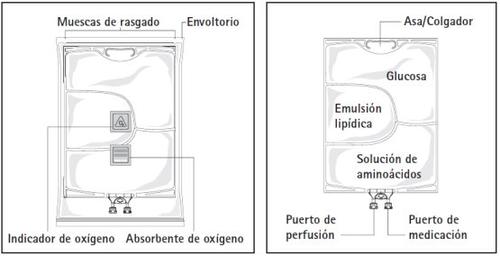
Figure A Figure B
Figure A: The multi-chamber bag is inserted into a protective wrapper. Between the bag and the wrapper are an oxygen absorber and an oxygen indicator; the oxygen absorber wrapper is made of an inert material and contains iron hydroxide.
Figure B: The upper chamber contains a glucose solution, the middle chamber contains a fat emulsion, and the lower chamber contains an amino acid solution.
The glucose and amino acid solutions are clear and colorless to pale yellow. The fat emulsion is white and milky.
The upper and middle chambers can be connected to the lower chamber by opening the intermediate seams.
The different container sizes are presented in boxes containing five bags.
Container sizes: 5 x 1,250 ml, 5 x 1,875 ml, and 5 x 2,500 ml
Only some container sizes may be marketed.
Marketing authorization holder and manufacturer
- Braun Melsungen AG
Carl-Braun-Straße 1 Postal address:
34212 Melsungen, Germany 34209 Melsungen, Germany
Phone: +49-5661-71-0
Fax: +49-5661-71-4567
More information about this medicinal product can be obtained from the local representative of the marketing authorization holder
- Braun Medical, S.A.
Ctra. de Terrasa, 121
08191 Rubí, Spain
This medicinal product is authorized in the Member States of the European Economic Area and in the United Kingdom (Northern Ireland) under the following names:
Austria NuTRIflex Omega plus B.Braun
Belgium Nutriflex Omega plus 38 g/l AA 120 g/l G, émulsion pour perfusion / emulsie voor infusie / Emulsion zur Infusion
Bulgaria Nutriflex Omega 38/120 emulsion for infusion
Croatia Nutriflex Omega 38/120 plus emulzija infuziju
Czech Republic Nutriflex Omega plus 38/120
Denmark Nutriflex Omega Plus
Finland Nutriflex Omega 38/120/40
France LIPOFLEX OMEGA G120/N5,4/E, émulsion pour perfusion
Germany NuTRIflex Omega plus novo
Greece Nutriflex Omega 38/120 plus
Ireland Omeflex plus emulsion for infusion
Italy Omegaflex AA38/G120 emulsione per infusione
Luxembourg NuTRIflex Omega plus B.Braun
Netherlands Nutriflex Omega plus, 38 g/l + 120 g/l, emulsie voor infusie
Norway Nutriflex Omega Plus
Poland Omegaflex plus
Portugal Omegaflex plus emulsão para perfusão
Romania Omegaflex plus emulsie perfuzabila
Slovakia Nutriflex Omega plus 38/120
Spain Omegaflex plus emulsión para perfusión
Sweden Nutriflex Omega 38/120/40
United Kingdom (Northern Ireland) Omeflex plus emulsion for infusion
Date of the last revision of this leaflet: 01/2024
Detailed information on this medicinal product is available on the website of the Spanish Agency for Medicines and Health Products (AEMPS) (http://www.aemps.gob.es/)
_____________________________________________________________________________
This information is intended only for healthcare professionals:
Parenteral nutrition products should be visually inspected before use to detect damage, color changes, and emulsion instability.
Do not use damaged bags. The wrapper, the main bag, and the tear-off seams between the chambers must be intact. Use only if the amino acid and glucose solutions are clear and colorless to pale yellow and if the lipid emulsion is homogeneous and has a white, milky color. Do not use if the solutions contain particles.
After mixing the three chambers, do not use if the emulsion shows a color change or signs of phase separation (oil droplets, oil layer). Stop the infusion immediately in case of a color change of the emulsion or signs of phase separation.
Before opening the wrapper, check the color of the oxygen indicator (see Figure A). Do not use if the oxygen indicator changes to a pink color. Use only if the oxygen indicator is yellow.
Preparation of the mixed emulsion
A strict observance of aseptic handling principles must be followed.
For opening: open the wrapper starting from the tear-off notches (Fig. 1). Remove the bag from its protective wrapper. Discard the wrapper, the oxygen indicator, and the oxygen absorber.
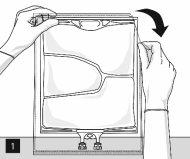
Visually inspect the main bag for leaks. Bags with leaks must be discarded, as their sterility cannot be guaranteed.
Mixing the bag and adding additives
To open and mix the chambers sequentially, roll the bag with both hands, first opening the tear-off seam that separates the upper chamber (glucose) from the lower chamber (amino acids) (Fig. 2).
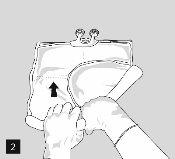
Then, continue applying pressure so that the tear-off seam that separates the middle chamber (lipids) from the lower chamber (Fig. 3) opens.
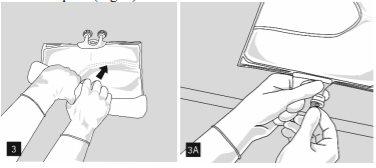
Once all chambers have been mixed and after removing the aluminum seal (Fig. 3A), it is possible to add compatible additives through the medication port (Fig. 4). Mix the bag contents well (Fig. 5) and visually inspect the mixture (Fig. 6). The mixture is a homogeneous oil-in-water emulsion with a white, milky color. There should be no signs of phase separation.
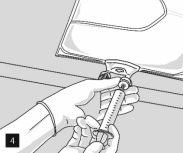
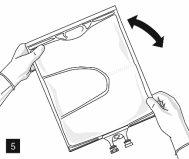
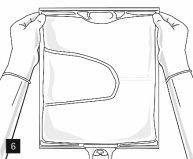
Omegaflex plus can be mixed with the following additives up to the specified maximum concentration limits or up to the maximum amount of additives after supplementation. The resulting mixtures are stable for 7 days at 2-8°C and for 2 additional days at 25°C.
- Electrolytes: the electrolytes already present in the bag must be taken into account; stability has been demonstrated up to a total of 200 mmol/l of sodium + potassium (sum), 9.6 mmol/l of magnesium, and 6.4 mmol/l of calcium in the ternary mixture.
- Phosphate: stability has been demonstrated up to a maximum concentration of 20 mmol/l for inorganic phosphate.
- Alanine-glutamine, up to 24 g/l.
- Oligoelements and vitamins: stability has been demonstrated with commercial multi-oligoelements and multivitamins (e.g., Tracutil, Cernevit) up to the standard recommended dosage by the manufacturer of the micronutrients.
The manufacturer can provide, upon request, detailed information on the above-mentioned additives and the corresponding validity period of these mixtures.
Preparation for infusion
The emulsion should always be brought to room temperature before infusion.
Remove the aluminum foil from the infusion port (Fig. 7) and connect the infusion equipment (Fig. 8). Use a non-ventilated infusion set or close the air ventilation if a ventilated set is used. Hang the bag from an infusion hook (Fig. 9) and perform the infusion according to the standard technique.

For single use. The container and unused residues must be eliminated after use.
The disposal of unused medicinal products and all materials that have come into contact with them will be carried out in accordance with local regulations.
Do not reconnect partially used containers.
If filters are used, they must be lipid-permeable (pore size ≥ 1.2 µm).
Validity period after removing the protective wrapper and after mixing the bag contents
Chemical and physicochemical stability has been demonstrated during the use of the amino acid, glucose, and lipid mixture for 7 days at 2-8°C and for 2 additional days at 25°C.
Validity period after additional mixing of compatible additives
From a microbiological point of view, the product must be used immediately after the addition of additives. Otherwise, the storage times and conditions before use are the responsibility of the user.
After the first opening (perforation of the infusion port)
The emulsion must be used immediately after opening the container.
Omegaflex plus must not be mixed with other medicinal products whose compatibility has not been documented.
Omegaflex plus must not be administered simultaneously with blood and
in the same infusion equipment due to the risk of pseudoagglutination.
- Country of registration
- Active substance
- Prescription requiredYes
- Manufacturer
- This information is for reference only and does not constitute medical advice. Always consult a licensed doctor before taking any medication. Oladoctor is not responsible for medical decisions based on this content.
- Alternatives to OMEGAFLEX PLUS EMULSION FOR INFUSIONDosage form: INJECTABLE PERFUSION, 3.92 g / 1.26 g / 7.21 g / 3.36 g / 4.2 g / 5.11 g / 2.94 g / 2.8 g / 4.76 g / 5.07 g / 4.06 g / 14.49 g / 0.28 g / 8.05 g / 3.5 g / 200 gActive substance: combinationsManufacturer: Baxter S.L.Prescription requiredDosage form: INJECTABLE INFUSION, 3.5 g / 200 g / 5.22 g / 1.88 g / 3.92 g / 1.26 g / 7.21 g / 3.36 g / 4.2 g / 5.11 g / 2.94 g / 2.8 g / 662 mg / 1.02 g / 4.76 g / 5.15 g / 5.07 g / 4.06 g / 14.49 g / 0.28 g / 8.05 gActive substance: combinationsManufacturer: Baxter S.L.Prescription requiredDosage form: INJECTABLE PERFUSION, 4.25 g / 300 g / 5.22 g / 1.54 g / 4.76 g / 1.53 g / 8.76 g / 4.08 g / 5.1 g / 6.2 g / 3.57 g / 3.4 g / 662 mg / 1.02 g / 5.78 g / 5.94 g / 6.16 g / 4.93 g / 17.6 g / 0.34 g / 9.78 gActive substance: combinationsManufacturer: Baxter S.L.Prescription required
Alternatives to OMEGAFLEX PLUS EMULSION FOR INFUSION in other countries
The best alternatives with the same active ingredient and therapeutic effect.
Alternative to OMEGAFLEX PLUS EMULSION FOR INFUSION in Poland
Alternative to OMEGAFLEX PLUS EMULSION FOR INFUSION in Ukraine
Online doctors for OMEGAFLEX PLUS EMULSION FOR INFUSION
Discuss dosage, side effects, interactions, contraindications, and prescription renewal for OMEGAFLEX PLUS EMULSION FOR INFUSION – subject to medical assessment and local rules.














